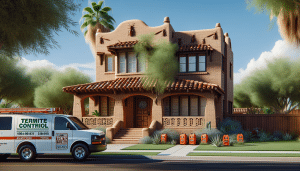Termites are quiet, patient — and terrible at telling you they’re there until the damage is already done. If you own a home in Maricopa County, you’ve probably heard the stories: sagging trim, hollow-sounding wood, or that unsettling crunch when you step on a floor that used to feel solid. You know what? One short termite consultation could save you thousands and a whole lot of heartache. Honestly, it’s less about panic and more about common sense.
Contents
- 1 Why get a consultation now? (Short answer: timing matters)
- 2 What actually happens during a termite consultation?
- 3 What will the inspector tell you? Straight answers, not scary stories
- 4 How treatments compare — plain talk
- 5 Cost, hassle, and the real return on investment
- 6 When should you call? (Spoiler: sooner than later)
- 7 Ready to stop termites before they stop your peace of mind?
Why get a consultation now? (Short answer: timing matters)
Let me explain. Termites don’t always show themselves. They work behind walls, under slabs, in landscaping timbers — often where you’d least expect them. Because Maricopa County stays warm most of the year, termites can be active for longer stretches than in colder places. After a wet monsoon, activity can spike. So, waiting until you see a swarm is like waiting for smoke before checking your roof.
Here’s the thing: early detection changes everything. You’re not just paying for Treatment; you’re buying options — simpler, cheaper repairs, less structural risk, and peace of mind. It sounds obvious, but people put this off. Why? Because termites are silent. Because the house looks fine from the driveway. But looks are deceiving.
What actually happens during a termite consultation?
A good inspector will do more than point and say “yep.” Expect a thorough walk-around and a look inside. They’ll check:
- Exterior foundations and soil contact: Wood touching soil is a red flag.
- Weep holes, AC units, crawl spaces: Moisture equals invitation.
- Visible wood and framing: Tapping, probing, listening for hollow sounds.
They may also use tools you’ve seen on TV — moisture meters, thermal imaging cameras, and sometimes even borescopes to look behind walls. You might hear brand names like Termidor for liquid termiticides or Sentricon for bait systems; these are common in our trade and worth mentioning because they come up in treatment talks.
Most consultations are free. Yes, really — Arizona Termite Control often offers no-cost Inspections. Why? Because it’s the smart first step for homeowners who want facts, not fear.
What will the inspector tell you? Straight answers, not scary stories
After the inspection you’ll get a clear report. No jargon-heavy lecture — just facts: infestation found or not, species likely involved (Subterranean termites are the usual suspect here), areas at risk, and treatment options. They’ll explain timelines: how long treatments take, when repairs should happen, and what to watch for afterward.
They’ll also talk warranties. Most professional Services include some form of monitoring or warranty. That matters. It’s one thing to spray and leave; it’s another to have ongoing checks and a promise to act if termites come back.
How treatments compare — plain talk
It helps to know the basic choices, so you can ask the right Questions:
- Liquid barriers (e.g., Termidor): Applied around the foundation to block or kill termites. Fast, effective, used a lot where homeowners want a direct barrier.
- Baiting systems (e.g., Sentricon): Stations placed in the soil; termites feed on bait and carry it back to the colony. Great for ongoing monitoring and less invasive landscaping impact.
- Localized treatments: For small, isolated spots — targeted foam or spot repairs instead of full-site measures.
- Fumigation: Rare for subterranean termites; more often used for Drywood termite infestations. It’s heavy-duty, but heavier on logistics (you’ll be out of the house for a bit).
Each method has pros and cons. Choice depends on the infestation type, your home’s construction (slab vs. crawlspace), and yes — budget. A good consultant will explain why one approach fits your house better than another.
Cost, hassle, and the real return on investment
Let’s be blunt: termite damage is expensive. Repairs to structural framing and finishes can run into the thousands. A consultation typically costs nothing; treatment varies widely but is almost always less than major repairs. Think of it like catching a small leak before it ruins the ceiling.
Insurance usually won’t cover termite damage, because it’s preventable. That’s one of those slightly infuriating homeowner facts, but it’s also motivation to act early. You pay now for a relatively small fix, or later you pay much more for rebuilding. It’s boring math, but true.
When should you call? (Spoiler: sooner than later)
Call when you see signs — mud tubes, discarded wings, hollow wood, or unexplained wood damage. But also call if you don’t see signs. If your neighbors have had infestations, or if the yard has untreated wood-to-soil contact, that’s enough reason. You don’t need a catastrophe to ask for help; a quick inspection is enough to tell you where you stand.
Seasonal note: termites are active year-round here, but the monsoon season can raise activity and make infestations show up faster. So if summer’s just ended and your yard’s been wet, you might want to get ahead of anything growing where it shouldn’t.
Ready to stop termites before they stop your peace of mind?
If you’re a Maricopa County homeowner, don’t wait until the floors or trim tell the story for you. A consultation gives clarity — and clarity helps you make calm, practical choices.
Call Arizona Termite Control at 480-660-3093 — or Request a Free Inspection“>Request a Free Inspection. Ask questions. Get a plan. Sleep better tonight knowing someone’s looked under the hood.




